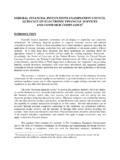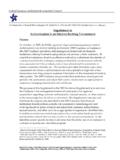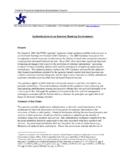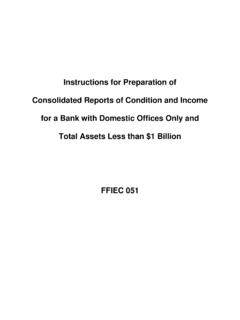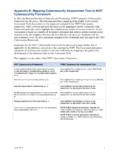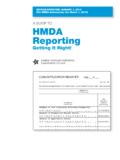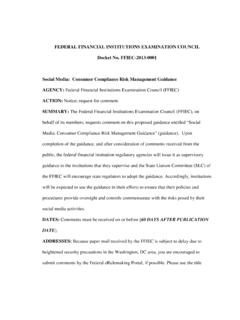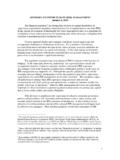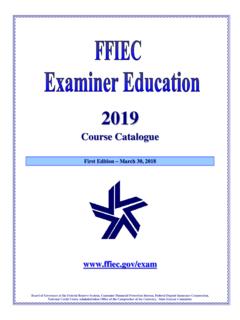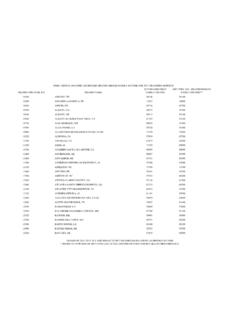Transcription of A Guide to CRA Data Collection and Reporting
1 EDITION EFFECTIVE for 2013 CRA Data Submissions (Due March 1, 2014) A Guide to CRA Data Collection and Reporting Federal Financial Institutions Examination Council Foreword 3 Contents Executive Summary: Compliance Responsibilities 4 Purpose of CRA 4 Who Must Report 4 When to Report 4 Reporting Requirements 5 File Specifications and Edit Validations 5 Collecting the Data 7 Composite Loan Data 7 Other Loan Data 14 Consumer Loans 15 Reporting the Data 16 Reporting Tools 16 Submitting the Data 17 Data Automation Cycle 18 Public Availability of Data 19 Glossary 22 Appendix A Regulation BB: Community Reinvestment 26 Appendix B Interagency Questions and Answers 48 Appendix C State and County Codes and MSA/MD Numbers 58 Appendix D Federal Supervisory Agencies 78 Appendix E Call Report Instructions 81 A Guide to CRA Data Collection and Reporting 2 Foreword In response to numerous requests and inquiries, the Federal Financial Institutions Examination Council (FFIEC) has prepared this Guide for Community Reinvestment Act (CRA) data reporters.
2 Data collec tion, maintenance, and Reporting are important aspects of financial insti tution evaluations under CRA. This Guide can be used as a resource when collecting and maintaining data, creating a submission, and posting lending data in the CRA public file. The FFIEC produces a public dis closure statement for every report ing institution. The disclosures and other CRA data are available from the FFIEC, by accessing the FFIEC Internet site, . Users of this Guide should be aware of its limitations. It relates only to the Collection , maintenance, and report ing of small business loans, small farm loans, and community develop ment data as well as the Collection , maintenance, and Reporting of other applicable loan data (except data on home mortgage loans) that may be considered during CRA evaluations. Although this Guide addresses many issues relating to these matters, new issues arise often.
3 For further infor mation about compliance, contact your federal supervisory agency (see Appendix D). Institutions may also contact the CRA Assistance Line at for assistance with data Collection and Reporting . Use of this Guide is not a substitute for familiarity with the CRA regula tions and the Interagency questions and answers (Qs&As) that interpret those regulations. The regulations and Qs&As may be revised from time to time. Thus, institutions should consult them to determine whether this edition of the Guide reflects the most recent revisions. Both are available in the appendices of this Guide and on the FFIEC s CRA website at . The FFIEC welcomes suggestions for making changes or additions that might make this Guide more helpful. Send your suggestions or comments to FFIEC 3501 Fairfax Drive Room B3030 Arlington, VA 22226.
4 Alternatively, you may provide feed back through A Guide to CRA Data Collection and Reporting 3 Executive Summary: Compliance Responsibilities Executive Summary: Compliance Responsibilities Purpose of CRA The Community Reinvestment Act of 1977 (CRA) is implemented by regulations of the Office of the Comptroller of the Currency (OCC), the Board of Governors of the Federal Reserve System (Board), and the Federal Deposit Insurance Corporation (FDIC) (collectively, the agencies) in 12 CFR parts 25, 228, 345, and 195. The CRA regulations require that information on business, farm, and community development lending by insured depository institutions that meet certain asset thresholds, determined annually, be made available to the public. CRA directs the agencies to encourage insured depository insti tu tions to help meet the credit needs of the communities in which they are chartered.
5 CRA does not prohibit any activity, nor is it intended to encourage unsafe or unsound lending practices or the allocation of credit. CRA requires that each insured depository institution s record in helping to meet the credit needs of its entire community, including low- and moderate-income neighbor hoods, be assessed periodically. That record is taken into account when considering an institu tion s applications for deposit facilities, including mergers and acquisitions. The CRA regulations contain differ ent evaluation methods for different types of institutions: the lending, investment and service tests for large retail institutions; the lend ing and community development test for intermediate small institu tions; the stream-lined performance standards for small institutions; the community development test for wholesale/limited-purpose institu tions; and the strategic-plan option for institutions with approved strate gic plans.
6 The Consumer Compliance Task Force of the FFIEC promotes con sistency in the implementation of the CRA regulations by periodically publishing Interagency Qs&As on community reinvestment and exami nation proce dures, and by facilitating uniform data Reporting . Who Must Report All state member banks, state nonmember banks, national banks, and savings associations that meet or exceed the asset size thresholds for both of the last two calendar years are subject to the data Collection and Reporting requirements of the CRA. The asset size thresholds are adjusted and announced by the federal banking agencies annually by December 31. The agencies also publish the current and historical asset size thresholds at Institutions that do not meet or exceed the asset size threshold have the option of submitting data voluntarily.
7 An institution that sub mits data voluntarily retains the option of being examined as a large institution. When to Report Data for a given year must be sub mitted to the Board, the designated processor for all of the agencies, by March 1 of the following year. Merging Institutions Following are three scenarios describing data Collection and Reporting responsibilities for the calendar year of a merger and for subsequent years. A Guide to CRA Data Collection and Reporting 4 Executive Summary: Compliance Responsibilities Scenario One Two institutions are exempt from CRA Collection and Reporting requirements because neither met the asset size threshold. The institutions merge. No data Collection is required for the year in which the merger takes place, regardless of the resulting asset size. Data Collection and Reporting would begin after two consecutive years in which the combined insti tution would have year-end assets that meet or exceed the small insti tution asset size threshold amount described in 12 CFR (u)(1).
8 Scenario Two Institution A, an institution with assets that meet or exceed the asset size threshold, and Institution B, an institution with assets below the asset size threshold, merge. Institution A is the surviving institu tion. For the year of the merger, data Collection is required for Institution A s transactions. Data Collection is optional for the transactions of the previously exempt institution. For the following year, all transactions of the surviving institution must be collected and reported. Scenario Three Two institutions that are each required to collect and report data merge. Data Collection is required for the entire year of the merger and for subsequent years, provided the surviving institution is not exempt. The surviving institution may file either a consolidated submission or separate submissions for each institution for the year of the merger, but must file a consolidated report for subsequent years.
9 Institutions That Did Not Originate or Purchase Small Business or Small Farm Loans An institution that has not originated or purchased any small business or small farm loans during the Reporting period would not submit the composite loan records for small business or small farm loans. However, all institutions subject to data Reporting requirements must submit the information dis cussed below under Reporting Requirements. Reporting Requirements At a minimum, an institution must submit, in electronic format: a transmittal sheet, a definition of its assessment area(s), a record of its community devel opment (CD) loans. (If an institu tion does not have CD loans to report, the record should be sent with 0 in the CD loan composite data fields), and information on small business and small farm loans, if applicable.
10 CRA data are aggregated on the census tract level. Each tract rep resents one record in an entire data submission. For example: Six different small business loans made in the same census tract constitute one composite record. Six different small farm loans, three in one census tract and three in another, constitute two composite records. Lenders Covered by Home Mortgage Disclosure Act If an institution is not required to collect home mortgage loan data by the Home Mortgage Disclosure Act (HMDA), it need not collect home mortgage loan data under the CRA exam. Examiners will sample an institu tion s home mortgage loans to evaluate its home mortgage lending. If an institution wants to ensure that examiners consider all of its home mortgage loans, it may collect and maintain data on these loans. Modification, extension and consolidation agreements (MECAs) are transactions in which an institution obtains loans from another institution without actually purchasing or refinancing the loans.
